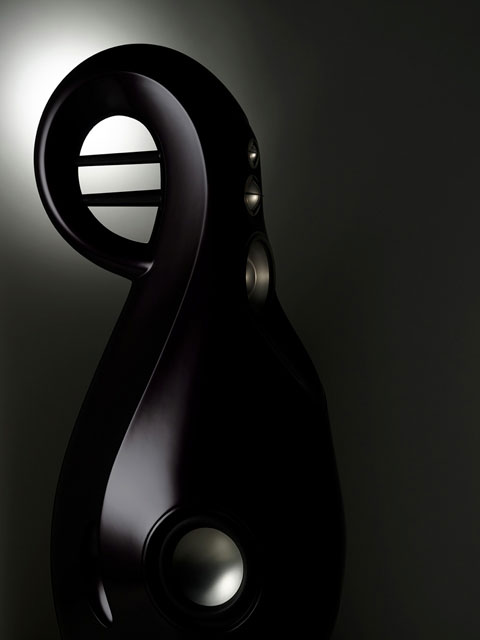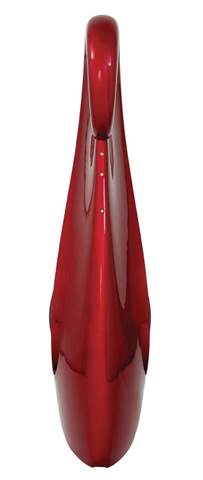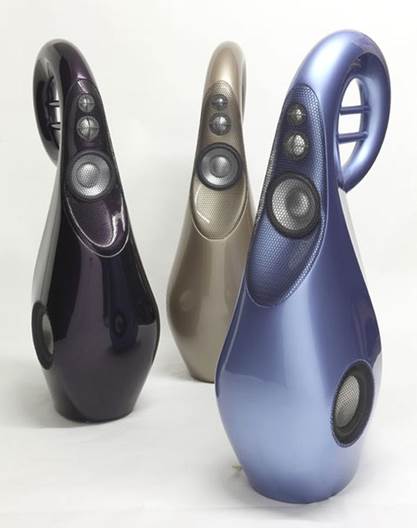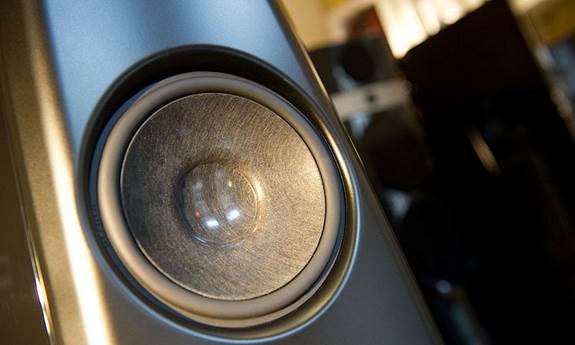The Giya G3
The G3 resembles the G1, but on a smaller scale, and costs
$39,990/pair instead of $64,990/pair. To cover the range above 220Hz, the G3
uses the same three aluminum drive-units as the G1: a 1" catenary-dome
tweeter operating above 3.5kHz; a 2" catenary-dome midrange unit covering
the region from 800Hz to 3.5kHz; and a 4.9" lower-midrange cone covering
220-800Hz, all three set into a shallow depression on the front baffle. The
crossover filters are all high-order. The ring-magnet topology permits the top
three drivers to be closely spaced. It’s just 10.5" from the top of the
tweeter dome to die bottom of die lower-midrange cone - above the 220Hz
crossover to the woofers, the G3 is basically a minimonitor, with all the
attendant advantages for dispersion and imaging.
Whereas the Giya G1 has two 11" aluminum-cone woofers,
mounted on opposite sides of the teardrop-shaped enclosure near the base and
loaded with a unique vented, tapered line, the G3 has twin 5.5" woofers,
still with aluminum cones and still loaded with a vented, tapered line. Along
with the lower- midrange unit, the three cone drivers have chassis carefully
shaped and cast to offer minimal obstruction to the cone’s backwave.

Vivid Audio Giya G3 Loudspeaker
The enclosure, molded from a glass-fiber-reinforced, balsa-
cored composite material, is still teardrop-shaped and, as in the G1, its top
section curves over to merge with the cabinet’s rear. However, because of the
G3’s smaller height - 45.7" vs 66.3" - the tubes loading the top two
drive-units, which were internal in the G1, emerge from the rear of the
enclosure and extend to meet the woofer line. The internal tapered line that
loads the lower-midrange unit now extends to the end of the woofers’ line,
where the latter meets the enclosure. The result is an attractive speaker that,
to my eyes, looks more elegant than the larger G1.
Electrical connection is via two pairs of binding posts
housed in a recess on the speaker’s base. This was the only gripe I had about
the G3’s design: connecting cables required the speaker to be tilted to one
side, and, with the thick cables preferred by audiophiles, there is only just
enough clearance in the recess to tighten the terminals, even when the six carpet-piercing
cones are fitted to the base. But as Laurence Dickie pointed out when I bitched
to him about this awkwardness, it actually affects only dealers and reviewers.
Once the dealer has installed the G3s in the customer’s home, the owner need
never be bothered by the problem.

Giya G3’s back
Listening
Vivid’s US distributor, Philip O’Hanlon of On a Higher Note,
set the Giya G3s up in my room. They ended up a little farther way from the
listening chair and closer to the sidewalls than the Wilson Alexias that had
preceded them, and O’Hanlon preferred the high-frequency balance and imaging
with the speakers toed-in, though not quite to the positions of my ears. This
worked for me, and I performed all of my listening with the speakers set up
that way. I also left off the vestigial wire-mesh grilles, the dome units still
being protected by cruciform grilles.
As always with a speaker review, I began my critical
listening by playing dual-mono pink noise from my Editor’s Choice (CD,
Stereophile STPH016-2), which gives me a handle on a pair of speakers’
frequency balance and imaging. Pink noise sounded smooth and seamless when I
sat with my ears on the Giya G3s’ tweeter axes, the two speakers sounding
identical. The noise signal acquired a hollow coloration when I stood up, and
sounded a bit midrange-dominant when I slouched in my chair so that my ears
were below the tweeter axes. There was no top-octave emphasis; in fact, the
G3’s treble was free of grain, and sounded sweet without being rolled-off or
dull. High-frequency clarity was superb.

The two woofers are mounted low on
the G3's sides to minimize the floor-bounce reflection.
With a dual-mono signal, a pair of perfect loudspeakers
should produce an infinitely narrow image precisely midway between them. The
G3s got close to this ideal with a central image that was narrow, well defined,
and didn’t “splash” to the sides at some frequencies as a result of frequency
anomalies or resonances.
The low-frequency, 1/3-octave warble tones on Editor’s
Choice were reproduced with full weight down to the 40Hz band, and with the
32Hz warble significantly reinforced by the lowest-frequency, diagonal mode in
my room. The 25Hz tone was both audible and free from obvious distortion,
though the 20Hz tone was inaudible at normal listening levels. With the half-step-spaced
toneburst track on Editor’s Choice, the tones spoke very cleanly down to 63Hz,
below which there was a slight lack of energy apparent before a big boost at
32Hz.
This exaggerated low bass is, as I explain in the
“Measurements” sidebar, due to the coincidence of the G3’s port tuning
frequency and the frequency of the lowest resonant mode in my room. The
exaggeration is just low enough in frequency that it didn’t add significant
coloration, though it did contribute to the “magnificence” I noted with some
orchestral recordings. But it made the choice of amplifier critical. For
example, the rumbling bass drum in the third movement of Mahler’s Symphony 2,
“Resurrection,” with Benjamin Zander conducting the Philharmonia Orchestra
(24-bit/192kHz ALAC file, Linn CKD 452), needed more control than the Pass Labs
XA60.5 amplifiers I reviewed in January could provide. Replacing them with the
MBL Corona C15 monoblocks (review to appear in a future issue) brought the low bass
under better control without affecting the Giya G3s’ superbly defined imaging
and transparent, grain-free midrange and highs.

The G3s could indeed play at high
levels without the sound saturating or coarsening
The control required by the G3’s woofers will make amplifier
choice critical for getting the best from this speaker. But even with the MBL
amplifiers, the double bass on my recording of Mendelssohn’s Piano Sextet from
the 1997 Santa Fc Chamber Music Festival, on Encore (CD, Stereophile STPH011-2),
was a touch on the gruff side, though pianist Christopher O’Riley’s insanely
fast spiraling arpeggios were reproduced with crystalline clarity. And the solo
kick drum that jump-starts “Slow, Happy Boys,” from Gov’t Mule’s The Deep End,
Volume 2 (ALAC file ripped from CD, Advance Music AT00006), was reproduced by
the Vivids with superb definition of the leading edges of its sound, plentiful
weight, and no low-frequency hangover. My Fender bass guitar in the channel-identification
tracks on Editor’s Choice spoke cleanly, with excellent definition, even at
high sound-pressure levels.
And the G3s could indeed play at high levels without the
sound saturating or coarsening. I could play at insanely loud levels the
cleanly recorded drum samples in “Fit Song,” from Cornelius’s Sensuous: la
musique de 21° siècle (ALAC files ripped from CD, Warner Japan EVE016). In
fact, my ears gave up while the speakers were still rolling up their
shirtsleeves and asking for more!